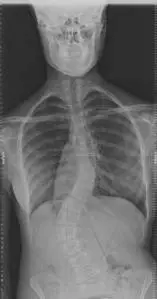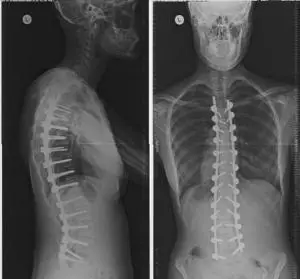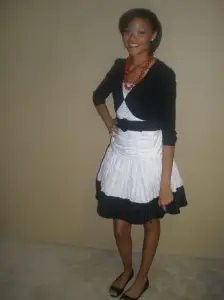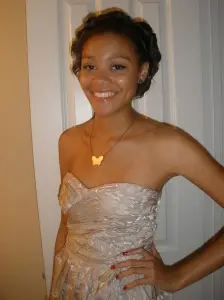Tressa Scott, a teenager in Allen, Texas, couldn’t stand up straight for more than a year — until the summer of 2010 following a complex spinal surgery performed by Dr. Isador Lieberman.
Before her surgery, Tressa had a 60 degree curve in her lower back and a 35 degree curve in her upper back. Now, the curves are balanced at just over 12 degrees each. “It’s remarkable how much difference there is just a day after surgery,” said Tressa’s mother, Norma Scott. “Her back is so nice and flush.”
Tressa’s X-Rays prior to surgery.

Scott said she first noticed that her daughter’s scoliosis had worsened in the summer of 2009 after Tressa hit a growth spurt. “She was standing up in the kitchen and I said, ‘Tress, why can’t you stand up straight?’ And she said, ‘I am standing up straight,’” Scott said. “I went over to her, and even though her legs were straight, her shoulders were off and her shoulder blade was protruding. It didn’t look right.”
Scott took Tressa to a Plano physician who referred her to Dr. Lieberman at the Scoliosis & Spine Tumor Center, a practice established by Texas Back Institute and Texas Health Presbyterian Hospital Plano. The center provides the most appropriate and least invasive treatment, support and coping strategies for adolescents and adults suffering from spinal deformities and tumors.
Dr. Lieberman performed surgery on Tressa using the SpineAssist® surgical robot, a technology he innovated. At the time, the robot used for Tressa’s surgery was one of only three robots in the United States and the only one in Texas. Accurate to less than half a millimeter, the surgical robot enables surgeons to plan the optimal surgery ahead of time using a computed tomography (CT)-based 3D simulation of the patient’s spine.
“Like a pilot in a flight simulator, I can map out the patient’s spinal anatomy and perform the entire procedure before the patient even arrives for surgery,” said Dr. Lieberman. “The robot doesn’t do the surgery, but it allows me to be more efficient and more precise, and to anticipate potential complications before they occur.”
After her surgery, Tressa was able to be a normal teen again. She gained a dramatically straighter spine – and also her self-confidence.
Tressa’s X-Rays after surgery.


“It’s amazing to see how much straighter my back is now,” said Tressa. “I’m standing up straighter, not leaning over to the side. The surgery gave me a new kind of confidence.”



